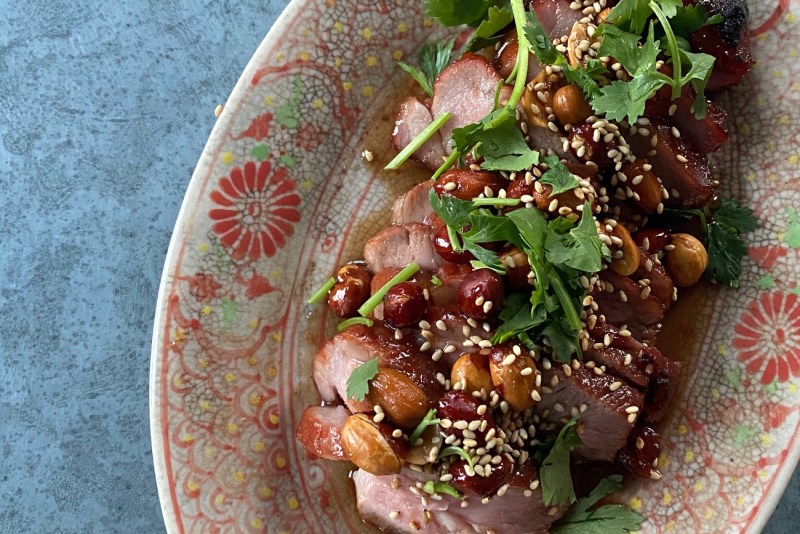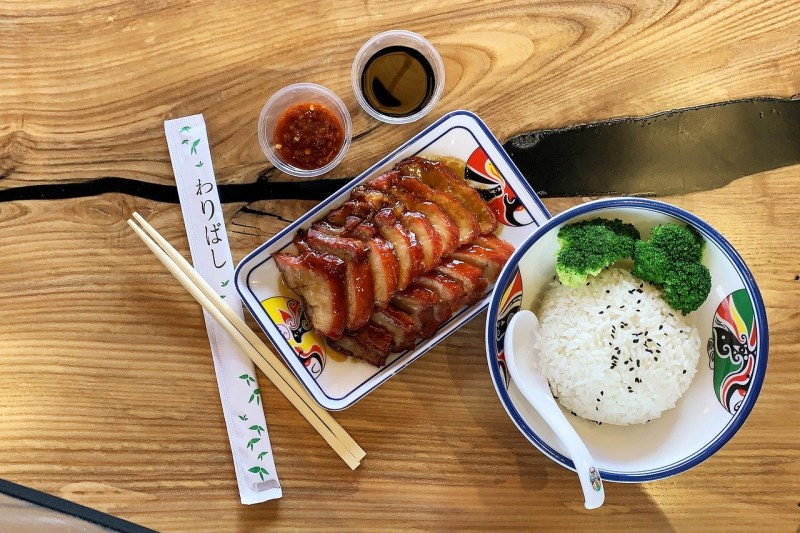There’s a common sight on the streets of Chinatowns — row upon row of glistening meat displayed in restaurant windows. The meats are varied, ranging from whole bronzed ducks to huge sides of crispy roast pork, a tantalizing sight to any meat lover.
There’s also another item — a red-colored, fragrantly sweet pork that’s delicious by itself or served with a bowl of white rice. This is char siu, Chinese barbecue pork, a delicacy that’s beloved throughout the Chinese community.
Selecting the pork

Char siu (or cha shao in Mandarin Chinese) is a specialty of the Southern Cantonese province of Guangdong. Since most Chinatowns in North America have historically been centers for Cantonese immigrants, char siu has an outsized influence on the cuisine of the Chinese diaspora.
There are many different versions of char siu throughout China and Southeast Asia. In Thailand, the preference is for lean cuts, typically using the loin. In Singapore, marinades will include more dark soy sauce and less red food coloring. In Hong Kong, fattier cuts like neck or shoulder are prized.
The most popular cut for char siu in China is pork shoulder cut into long, slender pieces. These days, many innovative chefs have started using heritage pork breeds like Kurobuta from Japan or Iberico from Spain for a high-end version of char siu.
Seasoning and cooking

Char siu’s patented sweet and savory flavor is the result of a combination of several key ingredients: honey, Chinese five-spice powder, red fermented bean curd, dark soy sauce, and hoisin sauce. Remember, Chinese dark soy sauce is different than the more common light soy sauce. Dark soy sauce is less salty, richer in color and used mainly for marinades or slow cooking. Thick maltose is also added at times for an extra glossy finish. Many restaurants will also add red food coloring to char siu for a pleasing vibrant color.
Traditionally, char siu is cooked hanging from hooks over indirect heat in a charcoal clay oven or a specially designed Chinese barbecue gas oven (shaped like a cabinet or refrigerator). To make char siu at home, home cooks can achieve great results using a toaster or conventional oven. An important tip to remember is to place your pork on a metal rack over foil. Since char siu marinade has sugar, the pork will burn and cling to the foil if not placed over a rack.
NiHao char siu

(By Chef Pichet Ong of NiHao restaurant in Baltimore)
NiHao is a contemporary Chinese restaurant located in the historic district of Canton, Baltimore. Spearheaded by Lydia Chang, the menu features collaborative Chinese cuisine by chefs Peter and Lisa Chang as well as Pichet Ong. Chef Ong is a five-time James Beard Award-nominated chef famous for combining classic techniques with innovative style, all inspired by his Southeast Asian heritage.
“My recipe is very old fashioned — and in uniquely original Chinese fashion, uses a very long list of ingredients,” said Chef Ong. “First, making a lu shui 卤水 (flavored or old water) that is remarkably spiced and complex and then incorporated in a sweet and savory marinade. I like my meats rich and unctuous, so I prefer neck or butt, which always goes well with a bowl of fresh, steamed rice and simply blanched leafy Chinese greens.”
Chefs’s tip: Be sure to check oven temperature and move the tray around as needed due to hot spots. “I like burnt ends of char siu but inside should remain juicy and tender. One may also cook it in an outdoor grill — it is BBQ after all,” said Chef Ong.
Ingredients:
- 2 tablespoons vegetable oil
- 2-inch piece of ginger, sliced into 1/4-inch pieces
- 2 green onion stalks, cut into 1-inch pieces
- 8 garlic cloves, smashed
- 4 pieces dried orange peel
- 1/4 teaspoon cloves
- 2-star anise
- 1 cinnamon bark
- 2 black cardamom pods
- 1/2 cup Shaoxing wine
- 1 cup rock sugar
- 1/2 teaspoon white pepper, ground
- 2 tablespoons red fermented tofu, pureed
- 1/2 cup dark red miso
- 1 cup maltose
- 1/2 cup honey
- 1 teaspoon red yeast rice, ground
- 3 tablespoons hoisin sauce
- 2 tablespoons light soy sauce
- 3 tablespoons sweet soy sauce, Kwong Hung Seng brand
- 4 pounds pork neck, cut into 2-inch strips, fat intact
Method:
- In a 4-quart stockpot, over medium-low heat, add oil and ginger, garlic, onion, orange peel, cloves, star anise, and cinnamon, and sweat until aromatics are caramelized and mixture is very fragrant, 6-8 minutes.
- Deglaze with Shaoxing wine, cover the pot, leaving an inch opening, and bring the mixture to a gentle boil.
- Add rock sugar pieces and let cook over low heat for about 10 minutes for flavor to be released and sugar to be dissolved and mixture slightly thickened. Let sit until mixture is cooled.
- Strain the mixture into a tall storage container. Add the red miso, maltose, honey, red yeast rice, hoisin and soy sauces. Using a stick blender, process the mixture until a smooth paste is formed.
- In a storage container with a lid, pour marinate onto the pork. Rub and mix around so it is evenly distributed, and meat is covered with marinade. Keep marinated meat pieces refrigerated for at least two days, turning them twice for flavor to be developed.
- Preheat the oven to 475 degrees Fahrenheit. Place meat pieces on a baking rack on another sheet pan lined with aluminum foil. Save the remaining marinade for basting. Add water to the aluminum-foil-lined baking tray until the water level comes up to 1/4 inch. This is to prevent smoking from the dripping.
- Bake at 475 degrees Fahrenheit for 12 minutes on the top rack of the oven until the meat starts to char. Reduce oven to 375 degrees Fahrenheit and cook for 10 minutes more.
- Remove the tray from the oven. Baste the meat using a pastry brush. Turn pork pieces over and baste the other side. Return the tray to the oven and cook for 10 minutes more at 375 degrees Fahrenheit.
- Remove the tray from the oven and baste the pieces with the remaining marinade. Return the tray to the oven, rotating it for even caramelization, for 10 more minutes. By this point, the total baking time should be around 42 minutes. Check the internal temperature of the meat with a probe thermometer. If it is 150 degrees Fahrenheit or above, the meat is done. If it isn’t, return tray to oven and bake for 5 to 10 minutes more.
- Let meat rest for 5 minutes at room temperature before slicing and serving.
Side dishes served with Chinese barbecue char siu
Besides a bowl of white rice, several sides may be served with char sui. Look for any of these on the menu.
- Stir-fried vegetables: A light and refreshing stir-fry with broccoli, baby corn, carrots, and snow peas is a perfect way to add some nutrients to your meal. You may also see other vegetables you like, such as bok choy, green beans, or snap peas.
- Chinese broccoli (gai lan): This leafy green vegetable has a slightly bitter taste that balances the sweetness of char siu. It’s usually stir-fried with garlic and oyster sauce for a simple yet flavorful side dish.
- Potstickers (gyoza): These pan-fried dumplings filled with pork and vegetables are a delicious and hearty side dish for char siu. The crispy exterior and savory filling complement the char siu perfectly.
- Hong Kong noodles (chow mein): These stir-fried noodles are popular street food in Hong Kong. They’re made with egg noodles, vegetables, and meat (optional) and can be served dry or with a light sauce.
- Wontons: These little parcels can be enjoyed in soup or fried. They’re filled with a savory mixture of pork, shrimp, or vegetables and make a delightful addition to your char siu feast.
- Char siu coleslaw: This is a fun twist on the classic coleslaw recipe. It’s made with shredded cabbage, carrots, and a dressing flavored with char siu sauce. The sweetness of the dressing complements the savory char siu, and the coleslaw adds a refreshing crunch to the meal.




